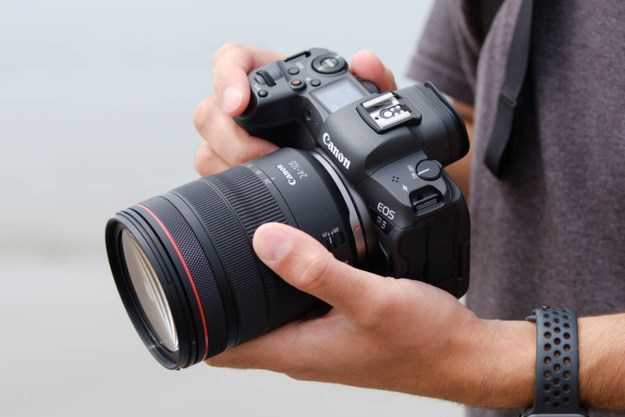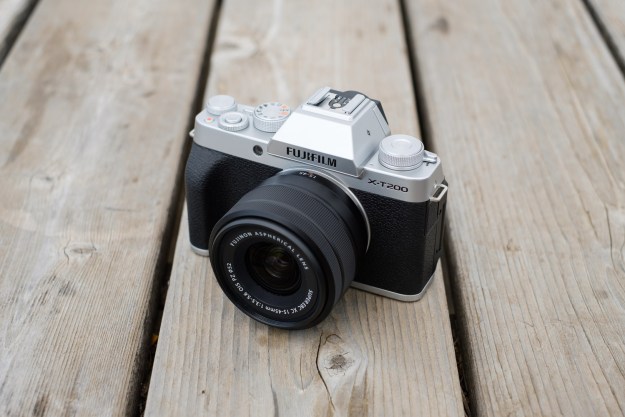- Compact; light; full HD camcorder with 15x zoom; 3.89MP CMOS sensor
- Still relatively expensive
- but getting there
Summary
There are two unshakeable truths in the CE biz: Technology never stands still, and prices always drop. Although you’ll occasionally kick yourself in the butt when you see the HDTV you bought drop by a third in a year’s time, this overall trend is a good thing, especially for procrastinators. The new Vixia HF200 is a good example. This new entry-level AVCHD camcorder records at 24 Mbps, compared to last year’s 17, which translates to better video on your TV screen. It also has an improved image sensor, a more powerful zoom lens, plus it costs less than the 2008 HF100. Now how bad is that? This is Canon’s most affordable high-def model, and we were delighted to put it through its paces to see if it was worth the wait.
Features and Design
The Vixia HF200 is purely SDHC card based (no internal memory) so it’s extremely compact and light. Just pop in a $35 16GB Class 4 card and you can record 80 minutes of best quality AVCHD video – more than enough for most events. For the record, the similar HF20 has 32GB of internal memory, but it costs $899.
The AVCHD camcorder is no prize winner in the looks department. It looks fairly ordinary with a combination of silver, gray and black finishes. However, it’s very small, fits comfortably in your palm, and has a very comfy strap. It measures 2.8 x 2.4 x 4.9 (WHD in inches), and weighs 13.8 ounces with the battery. You’ll have no problems carrying it around all the time. Canon calls it their “smallest, lightest HD camcorder” available, but the recently reviewed card-based Sony HDR-CX100 is smaller, lighter and cheaper. It’s just not as good.

On the right, you’ll find the adjustable strap, a compartment for the USB and mini-HDMI outputs, and a mode dial. With it, you can change between Dual Shot, camera and video. Dual Shot is Canon’s easy mode, allowing you to simply aim-and-forget for photos and videos. Unlike Sonys equivalent mode, you can record at highest video quality in this setting (MXP, 24 Mbps). You can only adjust the zoom, and cannot do any tweaking. The mode dial has to be turned to camera/video to do that.
The top has the power button, a zoom switch, shutter button, and hot shoe for optional mics and lights. On the back is the recessed slot for the battery, a record button, as well as compartments for DC-in to charge the battery, component out and mic in. As always, you’ll live on the left side with the swing-out LCD screen. It’s a 2.7-inch monitor rated 211K pixels – the same as the HF S10. In other words, it’s a very legible screen in most conditions, and if you hit the display button on the body, you can use it in direct sunlight. On the bezel is a four-way controller with center set button, a function key, and main controls such as record, wide/stop, tele/playlist, and playback. Like the HF S10, this camcorder has an excellent menu system. We only wish the main LCD adjustment wasn’t buried so deeply.
On the body is that vital display switch for boosting the LCD brightness, a video snap button, speaker, A/V out/headphone jack and the compartment for the SDHC card. As mentioned earlier, you need Class 4 or greater to record highest quality video (MXP, FXP), so make sure you have one. Or three, with prices so low. You’ll find a metal tripod mount and battery release on the bottom of the Made In Japan camcorder.
What’s in the Box
The carton contains the camcorder, battery, AC adaptor, remote, USB, A/V and component video cables. There’s also a hefty owners manual with 184 pages in English. One CD-ROM has Pixela ImageMixer 3 SE for saving and transferring videos, while the second has Video Tools for managing and editing movies. There’s also a digital video solution disk with ZoomBrowser EX for handling stills, along with a music data disk with tunes for background music used with the video snap feature.
With the battery charged, and a 6GB SDHC card in position, it was time to start recording.

The $749 Vixia HF200 records 1920 x 1080 videos at 24 Mbps, similar to the $1,299 HF S10. This is the best compression level available for the AVCHD format. However, it has a 3.89-megapixel CMOS sensor, rather than the 8.59-megapixel sensor of the more expensive model. The S10 dedicates 6 million pixels for video, versus 3 million for the HF200. Stills are similarly “challenged,” at 8MP for the S10, 3MP for HF200. We’ll see in a moment if the results are twice as good for an additional $550, and if this one holds up on its own.
Using this compact camcorder is a lot of fun. It feels right, the controls are within easy reach, and the menu is drop-dead simple to operate. We started off in the Dual Shot mode, then moved into camera and video to use features such as aperture and shutter priority. Once done, we reviewed the material on a 50-inch HDTV, on a PC monitor, and made 8.5-by-11-inch full-bleed prints of the stills. Overall, the results were very good.

Still photos were pretty impressive for 3-megapixel files. The HF200 uses nine autofocus points, which practically ensures sharp focus, and overall exposure was right on the money. Again, this is a Canon, and if they can’t figure out how to capture decent photos, something is really off in the world.
Conclusion
For $750, the HF200 is probably the best HD camcorder you can buy at this price range. The video is very good, stills are better than decent, it reacts quickly, has OIS, and feels just right. The most affordable “real” HD camcorder we’ve tested is the $599 Sony HDR-CX100, but the HF200 is so much better, we’d definitely urge you to spend the extra cash. For the record, Samsung’s new HMX-R10 will be the cheapest at $499 when it arrives this summer. In the meantime, we hate to sound like a skipping CD, but Canon is really leading the camcorder pack in 2009.
Pros:
- Compact, lightweight
- 15x zoom
- Very good videos
- Quality 3MP stills
- OIS cures the shakes
Cons:
- No Miss Universe contestant
- Wish it were cheaper
- Stereo sound not 5.1 surround
Editors' Recommendations
- Kokomo is a new social VR platform from Canon
- The best wide-format photo printers
- The best portable photo printers
- Lens teardown reveals how Canon made an affordable super-telephoto
- Canon reportedly targeted by ransomware cyberattack




